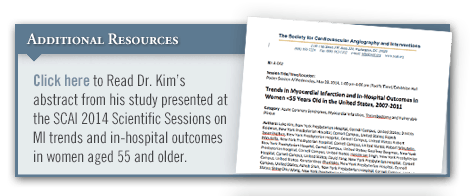Over time, the frequency of myocardial infarction (MI) in the United States has been declining overall as improvements have been made with regard to medical therapy for coronary artery disease. Although there has been a decline in the rate of ST-elevation MI (STEMI) in those aged 55 and older, the rate has remained steady in patients younger than 55 and among younger women. “Studies have shown that it’s harder to recognize the signs of MI in women,” says Luke Kim, MD, FACC, FSCAI. “Previous analyses indicate that women tend to receive less aggressive treatment than men.”
Analyzing Disparities
In a study presented at the Society for Cardiovascular Angiography and Interventions 2014 Scientific Sessions, Dr. Kim and colleagues analyzed data on about 13,000 women and more than 42,000 men aged 55 and younger who were hospitalized with an acute MI from 2007 to 2011 using the Nationwide Inpatient Sample database. The authors looked at temporal trends in MI as well as adverse in-hospital outcomes to compare findings by gender.
The researchers observed a slight decline in the number of MIs among younger women between 2007 and 2009 but little change after that. Women had more preexisting health problems than men, including diabetes, hypertension, kidney disease, peripheral vascular disease, congestive heart failure, and obesity. Women were also more likely than men to have non-STEMIs.
The study by Dr. Kim and colleagues also revealed that there were disparities in the treatment of MI. “Women who suffered an MI were far less likely than men to be treated with PCI or CABG surgery,” explains Dr. Kim. “They were also more likely to face serious health problems after their MI.” Even when women were treated with a revascularization procedure, they did not fare as well as men. The mortality risk was 10% higher among women than men, and the risk of stroke was 31% higher. In addition, the risk of excessive bleeding was 30% higher than among men, while risks for vascular complications were 33% higher.
Important Implications
“Greater efforts may be necessary to prevent MIs in younger women,” Dr. Kim says. “Considering that this patient group tends to have worse clinical outcomes, we may need to think beyond the traditional risk factors for MI during a diagnosis. Efforts are needed to become more committed to initiating preventive therapies as early as possible.” He adds that more research is needed to determine if men and older patients are actually being treated more aggressively with preventive medical therapy than younger women. “In the meantime,” he says, “clinicians can be proactive by being more vigilant about the risks of MI among younger women so that we can optimize outcomes in these patients.”




 TimH
TimH